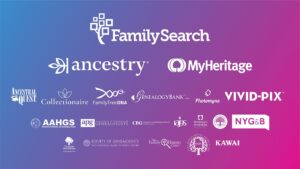by
Larry Pearce
3/24/21
 The Rocky Mountains and all their splendor are easily visible from the valley of the Great Salt Lake in Utah. This is perhaps a helpful comparison in understanding the hard, yet satisfying work of researching family history. Genealogy can be a steep climb, as the Mormons found out back in 1846 when they migrated from the East to Salt Lake City. Even after settling in the metaphorical basin of our beliefs about family, the taste can be bitter. But when and if our knowledge comes, we generally achieve a sense of identity and belonging that we can share with others. Though a proud Presbyterian, I prayerfully exemplify the Latter Day Saints and their generous contributions to helping families around the world find their origins. I believe that this is one of my chief callings in this life. And so in this article I’ll let that Church explain their motivation for building the giant empire and industry that is family history. I’ll give an overview of some of their subscription services and most of the free tools that go along with them. My most recent discovery was the annual free and virtual family history convention known at RootsTech, and I’m anxious to share what I found. But, in the end, what you do with all this knowledge will be up to you. You decide what you want to pay for and what you want to receive gratis, but I promise you, your family, and your descendants will be all the richer for your decision and hard work.
The Rocky Mountains and all their splendor are easily visible from the valley of the Great Salt Lake in Utah. This is perhaps a helpful comparison in understanding the hard, yet satisfying work of researching family history. Genealogy can be a steep climb, as the Mormons found out back in 1846 when they migrated from the East to Salt Lake City. Even after settling in the metaphorical basin of our beliefs about family, the taste can be bitter. But when and if our knowledge comes, we generally achieve a sense of identity and belonging that we can share with others. Though a proud Presbyterian, I prayerfully exemplify the Latter Day Saints and their generous contributions to helping families around the world find their origins. I believe that this is one of my chief callings in this life. And so in this article I’ll let that Church explain their motivation for building the giant empire and industry that is family history. I’ll give an overview of some of their subscription services and most of the free tools that go along with them. My most recent discovery was the annual free and virtual family history convention known at RootsTech, and I’m anxious to share what I found. But, in the end, what you do with all this knowledge will be up to you. You decide what you want to pay for and what you want to receive gratis, but I promise you, your family, and your descendants will be all the richer for your decision and hard work.
First, how did this group become interested in family history? I’ll let you read this background of the Church of Jesus Christ of Latter Day Saints (often called Mormons) at various sources, but let me start in 1840, when founder Joseph Smith began teaching about what he called “The baptism for the dead.” As many Christians see the rite of baptism as a sign of accepting Christ and therefore obtaining salvation, so do Mormons hold to St. Paul’s words, “Otherwise, what will those do who are baptized for the dead? If the dead are not raised at all, why then are they baptized for them?” (Updated New American Standard translation, 2002). Apparently, within the context of death being the final obstacle for humans, persons were being baptized by proxy for loved ones who had died. The early Church called this the work of Gnostics and is often discredited even to today by mainline Christians. Other well-accepted practices, such as infant baptism, arose from the baptism of the head of households for entire families. Anabaptists, such as my wife’s Amish ancestors, reject this, believing that only persons reaching the age of consent, can accept all that comes with baptism. The Mormons, however, teach that “those who have died may choose to accept or reject the baptisms done on their behalf.” To simply summarize, the LDS believers ask, “How can the proxy stand in for a deceased ancestor if that person is not known?” Elder Tad Callister quotes Hebrews 11:40 in a recent Quora online column saying, “The Prophet revealed to us the true meaning of genealogy. It is not to prove we are better than someone else, as was the reasoning of the Pharisees, but to perform essential gospel ordinances for our ancestors, recognizing that ‘they without us should not be made perfect’” Thus, the formation of many tools and ways of knowing stemming from the Mormons. In introducing the reader to the many opportunities available today to find ancestors, most likely for non-Mormons not having anything to do with baptism, I start with the Family History Center (FHC) in Salt Lake City. Also offering online classes, the library contains books, microfilm, and other materials covering over 300,000 families. The branches can be found in 140 countries. Many of the over 5,000 FHCs are located in area LDS churches, usually accessible by making an appointment by e-mail or telephone. Before the age of internet, I worked in centers in England and Pennsylvania. I should say that there was never any attempt on the part of the Church to convert me. Today, much of the material from these sources is available at the free FamilySearch.org, whose predecessor, the Genealogical Society of Utah, began in 1894. You will need to register your e-mail address and create a password there.
In introducing the reader to the many opportunities available today to find ancestors, most likely for non-Mormons not having anything to do with baptism, I start with the Family History Center (FHC) in Salt Lake City. Also offering online classes, the library contains books, microfilm, and other materials covering over 300,000 families. The branches can be found in 140 countries. Many of the over 5,000 FHCs are located in area LDS churches, usually accessible by making an appointment by e-mail or telephone. Before the age of internet, I worked in centers in England and Pennsylvania. I should say that there was never any attempt on the part of the Church to convert me. Today, much of the material from these sources is available at the free FamilySearch.org, whose predecessor, the Genealogical Society of Utah, began in 1894. You will need to register your e-mail address and create a password there. The only complaint I have with FamilySearch.org is the vast amount of information on persons with similar names and dates, pages and pages. I have found the site best used as a way of confirming information that you already have, or to begin some new lines of inquiry using any new information. We’ll talk about the sometimes rather expensive “big sister” to this site, Ancestry.com, below.
The only complaint I have with FamilySearch.org is the vast amount of information on persons with similar names and dates, pages and pages. I have found the site best used as a way of confirming information that you already have, or to begin some new lines of inquiry using any new information. We’ll talk about the sometimes rather expensive “big sister” to this site, Ancestry.com, below. Let me tell you about RootsTech, the family history, genealogy, and technology event that had its beginning at Brigham Young University in 1997 with 400 paid attendees. Since then it has taken place in Salt Lake City and online annually. In 2018 there were more than 28,000 in attendance. RT now claims to be the world’s largest such event, successor to three former conferences. Aside from being free and available online, the workshops and videos are available throughout the months that follow. Simply create an account at Family Search.org, sign-in, and choose one of the options on the toolbar. One items that’s truly helpful is called “My Playlist,” a storage spot for the links to the sessions you wish to save for viewing or re-viewing at a later date. I’m still enjoying programs from last February.
Let me tell you about RootsTech, the family history, genealogy, and technology event that had its beginning at Brigham Young University in 1997 with 400 paid attendees. Since then it has taken place in Salt Lake City and online annually. In 2018 there were more than 28,000 in attendance. RT now claims to be the world’s largest such event, successor to three former conferences. Aside from being free and available online, the workshops and videos are available throughout the months that follow. Simply create an account at Family Search.org, sign-in, and choose one of the options on the toolbar. One items that’s truly helpful is called “My Playlist,” a storage spot for the links to the sessions you wish to save for viewing or re-viewing at a later date. I’m still enjoying programs from last February. One other recommendation is the “Expo hall,” a list of logos that will take you to all the free and commercial goods and services available to genealogists and family historians. But, if the main reason you are reading this is to learn about the free online courses. There are many, and covering many cultures in many languages. My wife’s background is Swiss-German, and that is covered.
One other recommendation is the “Expo hall,” a list of logos that will take you to all the free and commercial goods and services available to genealogists and family historians. But, if the main reason you are reading this is to learn about the free online courses. There are many, and covering many cultures in many languages. My wife’s background is Swiss-German, and that is covered.
As my paternal genes come from England, I was drawn to three sessions by Dr. Amy Harris of BYU on researching ones British roots. At this link you’ll find a detailed syllabus, presentation slides, and the videos of her classes. She is quick to point out that many of the sources in the United Kingdom offer free log-ins but charge for materials. Be prepared to take notes and possibly replay her talks again for more details.
Another speaker on English family history is Robert John Bristow. Check out his course guides and slides for these classes: “All my Ancestors were English” and “Psycho-Ethical Genealogy: A Conversation.”
By clicking this “Explore Sessions” link, you’ll learn about all that is offered at the RootsTech.org virtual family history conference. As I’ve said before, all the videos and course guides and slides are free. I’ve found that communicating with the speakers via e-mail is quick and rewarding. I carry my laptop or iPad and earplugs with me and enjoy the various classes whenever I find myself having to wait somewhere. Oh, and have a notepad and pen handy!
Let me close with a brief discussion of Ancestry.com, a privately held online company based in Utah, the largest for-profit genealogy company in the world. Not only does it offer researching tools and historical records but is now one of the top DNA testing sites. While it doesn’t offer complete services along those lines, I found it to be inexpensive and easy to use. They regularly update my wife and my origins without additional costs. The most amazing thing about the DNA testing is the list of literally hundreds of “cousins” who have some “match” to your genes. Unfortunately, many of their e-mails are no longer active and most of these folks have not made their contributions public.
May I recommend a 13-minute YouTube video by Ancestry’s DNA specialist, Kelly Becker. This year’s slide show is the second of three that she has done for the annual RootsTech conferences. If you’ve had your DNA tested by Ancestry, most of what she covers will look familiar, although some features are new and may not have arrived with your regular updates. Be patient. After viewing, I came away with several new ideas.
Whether or not you pay for the separate DNA service there, as I said earlier, compared to free FamilySearch.org, regular membership in Ancestry.com can be costly. If you join, and I recommend at least taking advantage of the free short, trial membership, be prepared to use the Ancestry platform exclusively and extensively while a member. I remember literally locking myself in my office over the Christmas holidays, not wanting to be disturbed while working this “present” our kids got for me. While Ancestry offers what they call a “Shoebox” in which to store family history information for later use, they also “keep” every bit of work you’ve done in building family trees and attaching photos and documents. If you decide to make this material public, even after you drop the service, the world is welcome to view and use all of this. Although I quit my membership years ago, I get regular solicitations containing “hints,” little nuggets of family history turned up by others that you may or may not be able to access. Ironically, maddeningly so, many of the “hints” are nuggets that I discovered, on Ancestry.com in perpetuity free to members but not to me.
In conclusion, the family history and genealogy industry is constantly growing and changing. Like the proverbial tiny fish in the ocean, small start-up companies are always being formed, while larger corporations are taking them in, either to reduce competition or to expand their services. What you might think is only a hobby is really part of the capitalist realm, appealing an ever-increasing number around the world. “Bottom line,” keep checking your old sources and looking for new ones. One of the best ways I can think of to do this is by putting “RootsTech.org” and other such links on your tool bar. By the way, I’ll soon be posting an article on Artificial Intelligence (AI), as it pertains to researching family history, at this site, the ever more popular, and very scientific, tool(s) for allowing your computer to do the hard work for you.
Last revised 5/12/21




